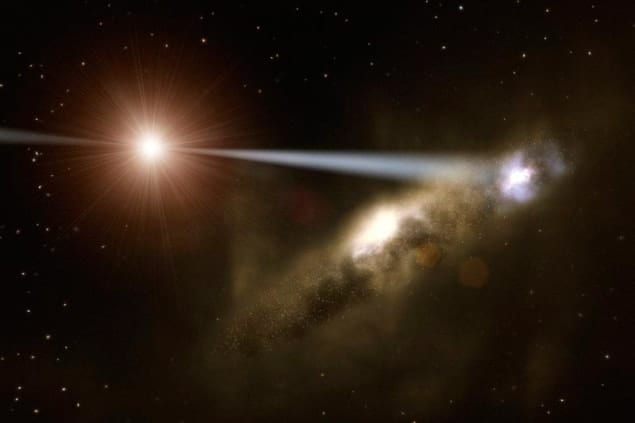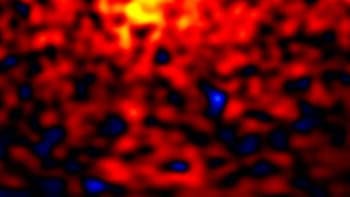
A quasar is a black hole that draws in matter from the surrounding space. Its strong gravitational field imposes a huge kinetic energy on this matter, causing it to radiate across a wide range of wavelengths. According to new research, however, quasars do more than consume matter – they can also create stars. Indeed, David Elbaz, of the CEA in Saclay, France, and colleagues believe that quasars might in fact be capable of building entire galaxies.
Supermassive black holes, up to hundreds of millions times more massive than the Sun, are found in the centre of most large galaxies. The black holes inside nearby galaxies – and in the Milky Way – do not consume matter and in these galaxies stars are known to form when gas and dust particles cool and collapse due to gravitational instabilities. However, the star-forming process and therefore the relative ordering of black hole and galaxy creation is less clear-cut in the early universe. “Some models suggest a tightly linked co-evolution between black holes and the stars around them,” says Elbaz. “It is possible that the black holes grow faster in the beginning and then the galaxies catch up, but astronomers have no real grasp yet on the exact physics involved in this mechanism.”
In 2005 astronomers carried out a detailed study of 20 quasars about four billion light years from us and discovered that 19 of these, as expected, consisted of supermassive black holes surrounded by a galaxy. However, one of them, HE0450-2958, contained no trace of an accompanying galaxy. Elbaz and colleagues have now studied this quasar at infrared wavelengths using the Hubble Space Telescope and the European Southern Observatory’s Very Large Telescope in Chile, in order to look for dust that might be obscuring the galaxy. However, although they found evidence for dust heated near to the quasar itself, they found no sign of a hidden galaxy. Instead, they found that an apparently unrelated galaxy some 22,000 light-years away from the quasar is producing stars at the equivalent of about 350 Suns per year – some 100 times faster than typical galaxies in the local universe.
Although the quasar is still ‘naked’, it will eventually be ‘dressed’ David Elbaz, CEA Saclay
Combined with earlier observations showing that HE0450-2958 is injecting radio jets and accompanying gas into the galaxy, the researchers concluded that the quasar might be responsible for this rapid star formation and therefore creating its own host galaxy. They point out that the quasar is moving towards the galaxy relatively slowly – at a few tens of thousands of kilometres an hour – and that it should therefore merge with it at some point in the future. “Although the quasar is still ‘naked’,” says Elbaz, “it will eventually be ‘dressed’ when it merges with its star-rich companion. It will then finally reside inside a host galaxy like all other quasars.”
More powerful jets
Elbaz and co-workers maintain that their hypothesis could explain a well-established correlation between the mass of a black hole and the mass of the stars that surround it (it is always smaller by about a factor of 700) because more massive black holes would produce more powerful jets, leading to more star formation. The researchers acknowledge that HE0450-2958 might still be found to sit within a galaxy – such a galaxy would just have to be much fainter or much smaller than the galaxies typically found around quasars. But they maintain that even if such a galaxy were found this would not fundamentally change their conclusion. “We would still have found that a quasar can drive the formation of stars, and given that the companion galaxy will eventually merge with the quasar it will still make up a significant fraction of the final galactic mass.”
Abraham Loeb, an astronomer at Harvard University, believes that Elbaz’s team “provides interesting new data on the environment of HE0450-2958”. However, he cautions that the rapid star formation in the neighbouring galaxy might be explained using a different mechanism – galaxy merger – if the quasar is indeed found to be already immersed in a galaxy. “Numerical simulations of galaxy mergers indicate that during close passage, cold gas is driven towards the centres of the interacting galaxies and that this leads to star formation” he says, adding that “one should also keep in mind that this is only one system, and generalizing the conclusions to all quasars is premature”.
Elbaz agrees on the importance of searching for similar systems in the distant universe – in other words looking for quasars and star-forming regions separated by significant gaps – using the next generation of ground- and space-based telescopes. He acknowledges that until they do this their hypothesis is likely to remain controversial because the universe contains huge amounts of gas that could be used to create new stars and yet galaxies have been creating ever fewer stars, leading many researchers to believe that gas-guzzling quasars in fact suppress star formation. “It may well be that quasars first help star formation, then in a second stage quench it,” he adds.
The research is published in the journals Astronomy and Astrophysics and The Astrophysical Journal.



